Module 2: Harvesting on Your Woodland
Lesson Two - Best Management Practices in Forestry
A Best Management Practices Manual has been developed for Nova Scotia. The manual discusses the important aspects of woodland management and provides a guide for those interested in carrying out forestry operations.
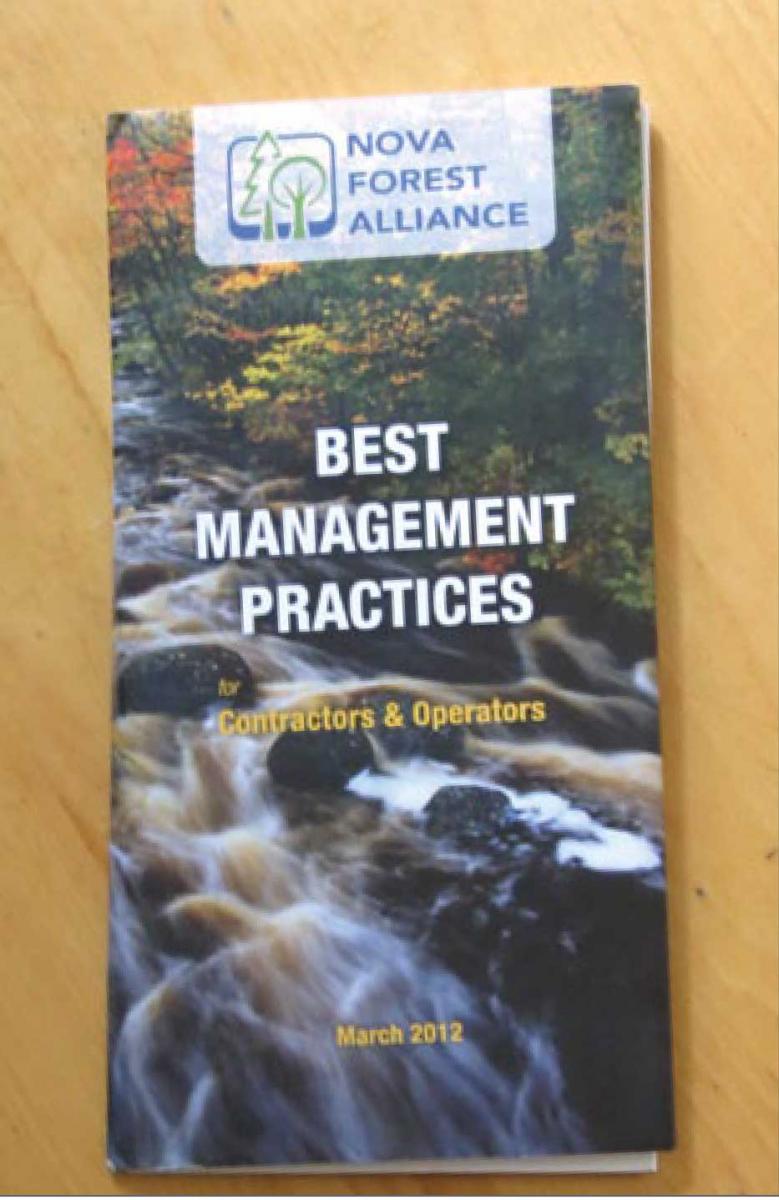 |
| Best Management Practices manual |
Wildlife Habitat and Watercourse Protection regulations
Of particular interest to those contemplating harvesting activities, are Nova Scotia’s Wildlife Habitat and Watercourse Protection Regulations. You should become familiar with these regulations, since they may significantly impact the ways in which you manage your woodland.
The Wildlife Habitat and Watercourse Protection regulations can be summarized as follows:
- Buffer strips must be left along watercourses
- Because the area next to a watercourse provides food and shelter for many species of wildlife, Special Management Zones at least 20 m in width must be left along any watercourse that is 50 cm or more in width. Some harvesting is permitted within this zone under certain conditions.
- Legacy/wildlife clumps must be left in any harvested area greater than 3 hectares
- At least 10 living trees must be left standing for each hectare harvested. These trees should be left in clumps, with a minimum of 30 trees per clump, and the clumps should be representative of the area that was harvested.
- Coarse woody debris should be left in the harvested area
- Wildlife often utilize standing dead trees, fallen trees and rotting logs for habitat. Decaying wood is an important source of nutrients for the next forest.
 |
| Aerial view of legacy/wildlife clumps. Photo courtesy of NSDNR |
Nova Scotia’s Code of Forest Practice
Ecosystem-based forest management is at the center of Nova Scotia’s Code of Forest Practice. Published in 2010, this document promotes sustainable forest management on all forest lands in the province. Forest ecosystem classification and pre-treatment assessments serve as the basis for stand-level planning within the context of forest landscapes.
The Code of Forest Practice addresses forest harvesting, and indicates that provincial harvest levels will be sustainable. Natural regeneration will be encouraged, and that where it is insufficient or of inferior quality, planting or seeding will be undertaken.
The Value of Forest Ecosystem Classification in Making Harvesting Decisions
When it comes to harvesting, forest ecosystem classification can be used to determine whether a particular stand is suited to partial harvesting or to clearcutting, or whether the stand should be harvested at all.
In all situations, an accurate appraisal of the forest site through forest ecosystem classification (FEC) will determine whether heavy equipment should be operated on the soil. By assessing ground vegetation and soil types, soil compaction and rutting hazards can be determined, as well as windthrow hazard of the remaining trees in a partial harvest.
Forest vegetation can be used to help classify forest ecosystems, since different plant species have specific requirements for moisture, sunlight and nutrients. Certain plants grow only on poorly drained sites, in which the water table is usually close to the surface. During a warm dry summer, it may be difficult to determine if a forest site is poorly drained since there is little or no moisture visible. Plants can give us clues. Some plants, like cinnamon fern and sphagnum moss, are called indicator plants because they indicate a normally wet site and cannot survive on well-drained sites.
 |
| The presence of cinnamon fern could indicate a west forest site. |
When soils contain more than 20 percent clay and less than 50 percent sand, they may be prone to compaction and rutting. While rutting causes obvious above-ground disturbance, the impact to the sub-surface soil structure can be permanent and profound. Tree roots and soil organisms can be damaged. Lateral movement of water can be impeded as compaction crushes vital tiny air spaces in the soil. These spaces, called pores, also provide valuable oxygen to organisms that promote the cycling of nutrients and aeration within the soil. Assessing forest soils, then, is of paramount importance in operations in which heavy equipment is to be used.
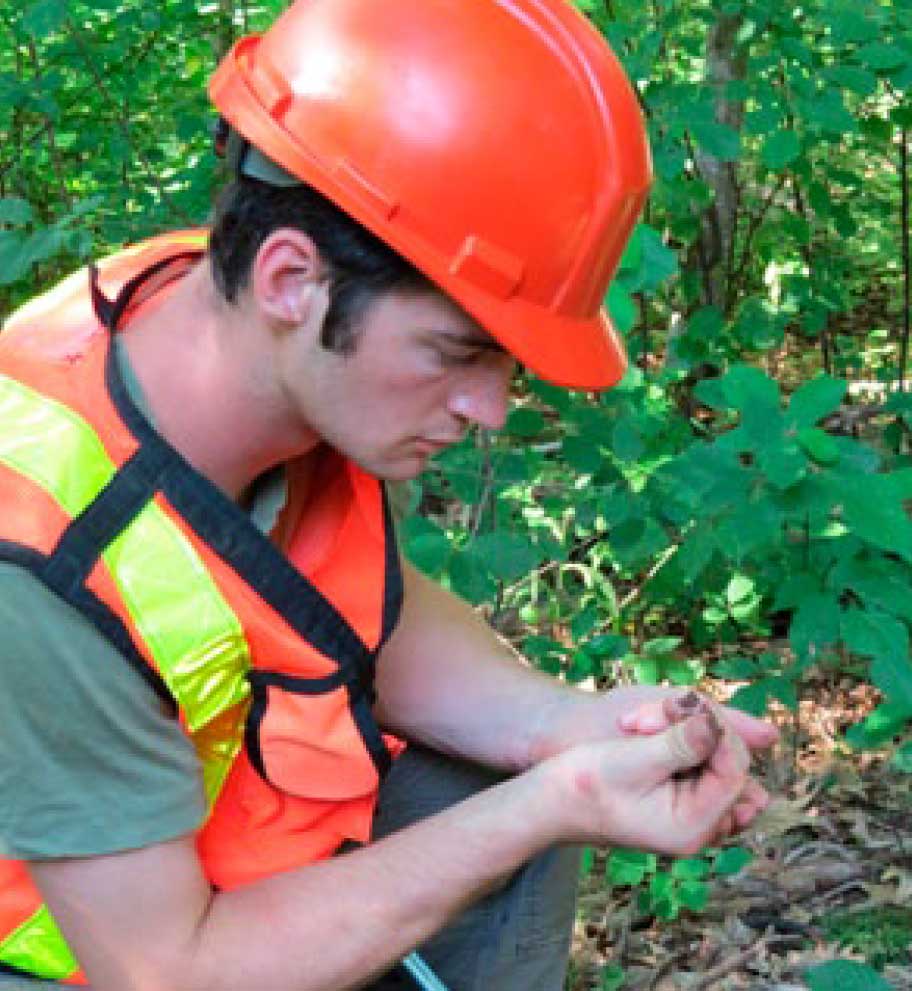 |
| Sampling soil texture is an important step in identifying soil type. |
The procedure used in this determination is called pre-treatment assessment and is a formal method of collecting data on a stand. Pre-treatment assessment is an accurate way of gauging the quality of trees in a stand and whether crop trees that are left after a partial harvest will be vulnerable to windthrow. Pre-treatment assessment also assesses the soil on a site to determine whether the soil will be susceptible to compaction and rutting if heavy equipment is used during wood extraction.
Forest professionals that are FEC-certified can help you with this important step in the decision- making process. If a stand is found to have good quality trees which will not decrease in quality or value over the next 15 years, and if the soil is well drained and deep enough to allow strong tree rooting, a partial harvest may be recommended. If, on the other hand, most trees are of poor quality and will not improve over 15 years, and the soil retains too much moisture or is shallow, partial harvesting may not be the best option.
See Appendix A for further information on how pre- treatment assessments are conducted.
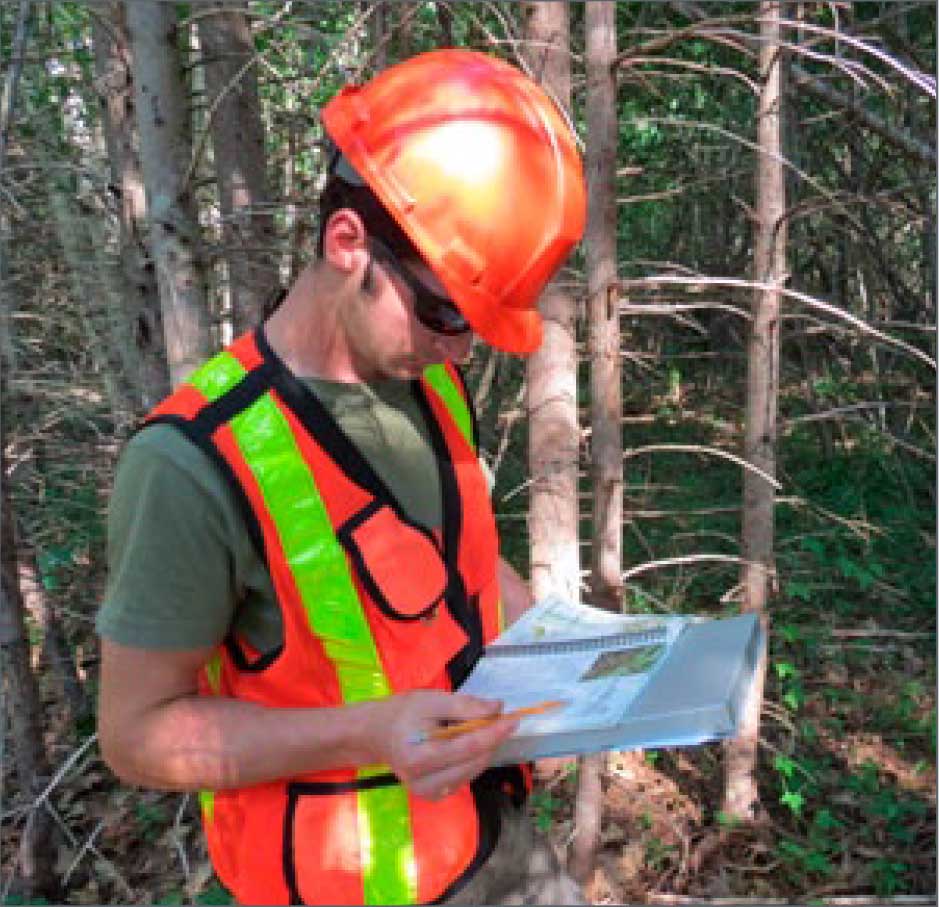 |
| Using Nova Scotia's Forest Ecosystem Classification guide is an essential step in making effective harvest prescriptions |
If timber production is an important value to you, harvesting trees is unavoidable. How you go about harvesting is a significant decision which may involve alternate choices. It is always a good idea to begin by classifying your forest ecosites
Forest Growth and Succession
To help in understanding how forests grow and reach a stage at which trees are ready for harvest, knowledge of a few terms is important.
We have discussed how site conditions influence the types of forest vegetation that become established on a site. Forests are not static communities. They are constantly changing in accordance with successive patterns of vegetation growth and natural forces which shape their structure. These changes can be subtle, such as a slowly decaying tree that eventually falls. Or they can be as dramatic as a hurricane tearing through a forest, toppling trees like pick-up sticks. These forces are called natural disturbances, and they often determine the future composition and structure of our woodlands.
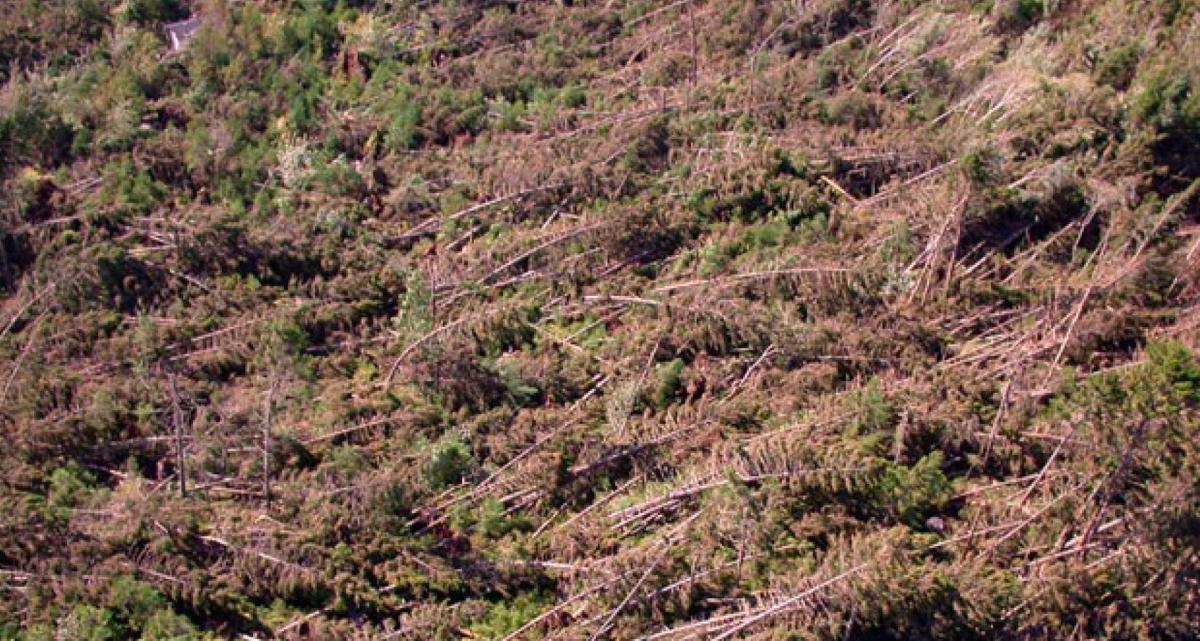 |
| Hurricane damage. Photo courtesy of NSDNR |
In Module 7 we learn that, over time, forest communities develop in an orderly and predictable way. This development - called succession - usually involves changes in species and ecological processes in the community, and is governed by disturbance and tree longevity and shade tolerance. At any
point in time, successional development of a forest community is in one of three stages: early, middle or late successional stage.
successional stages
In an early succesional stage, trees are often fast- growing, shade-intolerant species that vigorously colonize sites that may have been harvested, burned by fire, or cleared for agriculture or other development. Examples of these tree species include:
- Trembling aspen
- White birch
- Gray birch
- Red maple
- Jack pine
- Tamarack
- Red pine
Other, more shade-tolerant species may become established at the same time as shade-intolerant species, but can slowly develop in the shade cast by the taller, faster-growing trees. These can include:
- Balsam fir
- Eastern hemlock
- Red spruce
- Sugar maple
- Yellow birch
- White ash
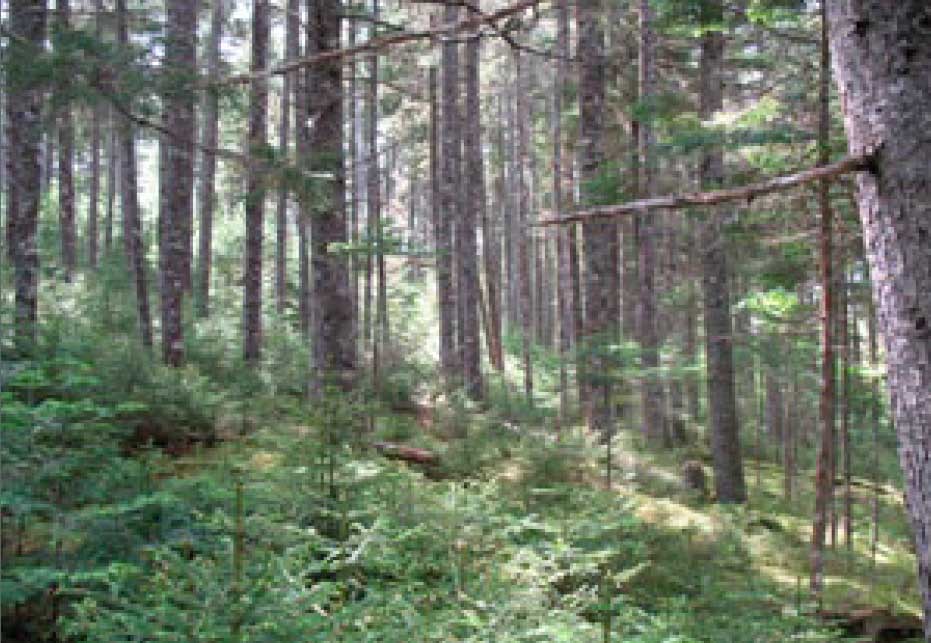 |
| Healthy and vigorous red spruce |
Black spruce is a significant tree species in the forests of Nova Scotia. While it may not be considered a part of the “traditional” Acadian forest, it occupies an important place on the landscape of our province. Sites that may be too wet and nutrient-poor for other tree species may support, and repeatedly regenerate to, stands of black spruce
It is important to note that not all trees are the same size when the forest community is still in an early successional stage. While most of the trees in the community are close to the same age, the more vigorous trees may be much larger than those growing in shade.
As decades pass, an early successional stage becomes mid-successional. Changes in the community are reflected in a shift in tree species, as more shade-tolerant, longer-lived trees begin to replace the fast-growing shorter-lived species. Balsam fir, red spruce and red maple may replace the trembling aspen, white birch and grey birch. The mid-successional stage usually contains a mix of characteristics of both the early- and late- successional stages.
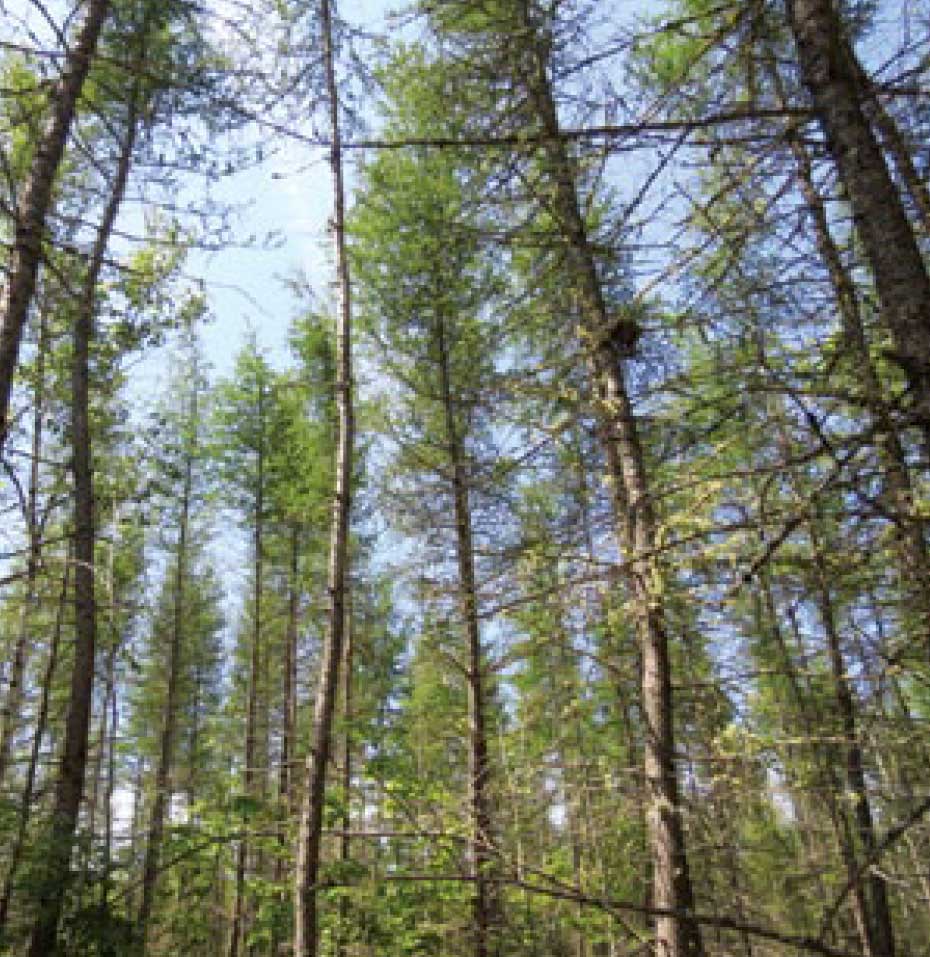 |
| Early successional stand of tamarack |
Late-successional communities are often composed of mostly long-lived, shade-tolerant tree species that become established decades – even centuries – after an early-successional forest. Red spruce, eastern hemlock, sugar maple, yellow birch and beech are examples of species that are found in late- successional forests, although they may not all be found together. Late-successional hardwood stands, for instance, can be composed primarily of sugar maple, yellow birch and beech, while containing few other species.
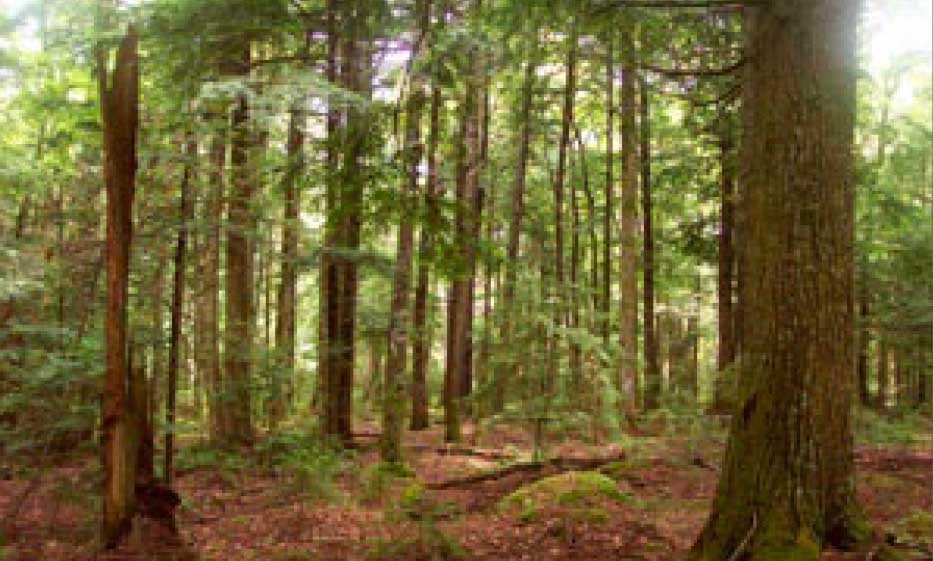 |
|
Late successional stand of hemlock and yellow birch. Photo courtesy NSDNR |
Natural disturbance
Nova Scotia is uniquely posed on the continent of North America. Jutting out like a thumb into the North Atlantic, the province is surrounded on at least two sides by hundreds of miles of open sea. Ice and snow slam into our shores during winter. Sleet batters our forests in early spring, sheathing trees in ice crystals that snap twigs and break branches. Summer sunshine is replaced by autumn rain and gales that every few decades turn into high-energy hurricanes, hammering huge swaths of trees to the forest floor. These seasonal disturbances are not so subtle, and are fortunately rare – but they do occur.
More obvious are the human disturbances that impact forests, such as land-clearing, grazing and forest harvesting. Sometimes disturbances are the result of a combination of human-caused and natural events. In many areas of the province, abandoned fields that were cleared many years ago now support stands of white spruce. An insect called the spruce bark beetle has infested many of these spruce stands, resulting in widespread mortality of the trees. Left alone, these stands eventually fall apart, creating conditions for the establishment of other vegetation.
Forest fires were more common 200 years ago than they are now. When land was being cleared for agriculture, entire forests were burned to make clearing easier. As railroads were built across the province, steam engines and sparks from steel wheels often started fires in the brush adjacent to the tracks. We still see evidence of these fires today, in forest stands that have developed in the burned- over areas.
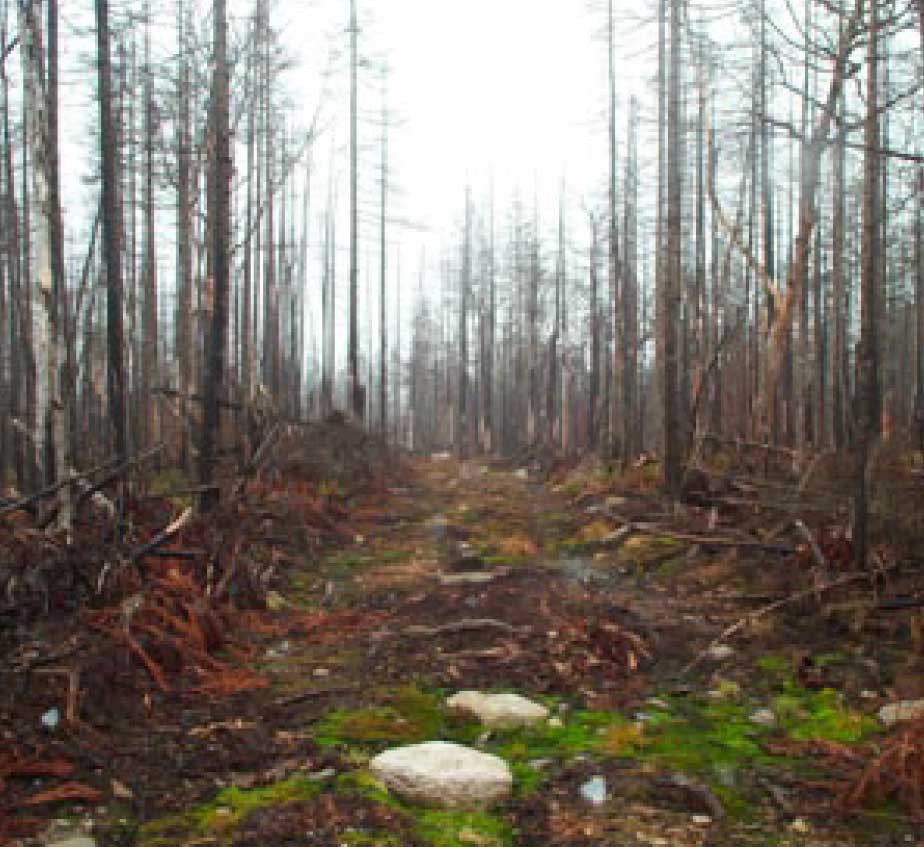 |
| Fires can be large natural disturbance events. Photo courtesy of NSDNR. |
Fires start naturally when lightning strikes a site that may contain combustible material. This could include standing dead trees (called snags) that easily combust under the right conditions.
During the last 50 years we have developed effective fire suppression techniques that reduce the likelihood that a forest fire will rage out of control over large areas. As a result, forest fires are no longer a significant form of natural disturbance in Nova Scotia.
A less obvious form of natural disturbance is the gentle progress of decay in a tree that may occur from wounds in its bark, or root-rot lesions from fungi that live in the soil. The decline of a tree can be nearly unnoticed, until one day it topples to the ground. The tree may break off above the ground, or tear the forest floor as the great mass of roots hinges upwards, revealing the secrets of the soil. Sunlight suddenly replaces shade, and an opening is created in the forest. Insects, centipedes and millipedes all scurry for cover as the roof is suddenly torn from their home. Birds flock to the feast. It is a fresh new start for some organisms that prefer sunlight over shade.
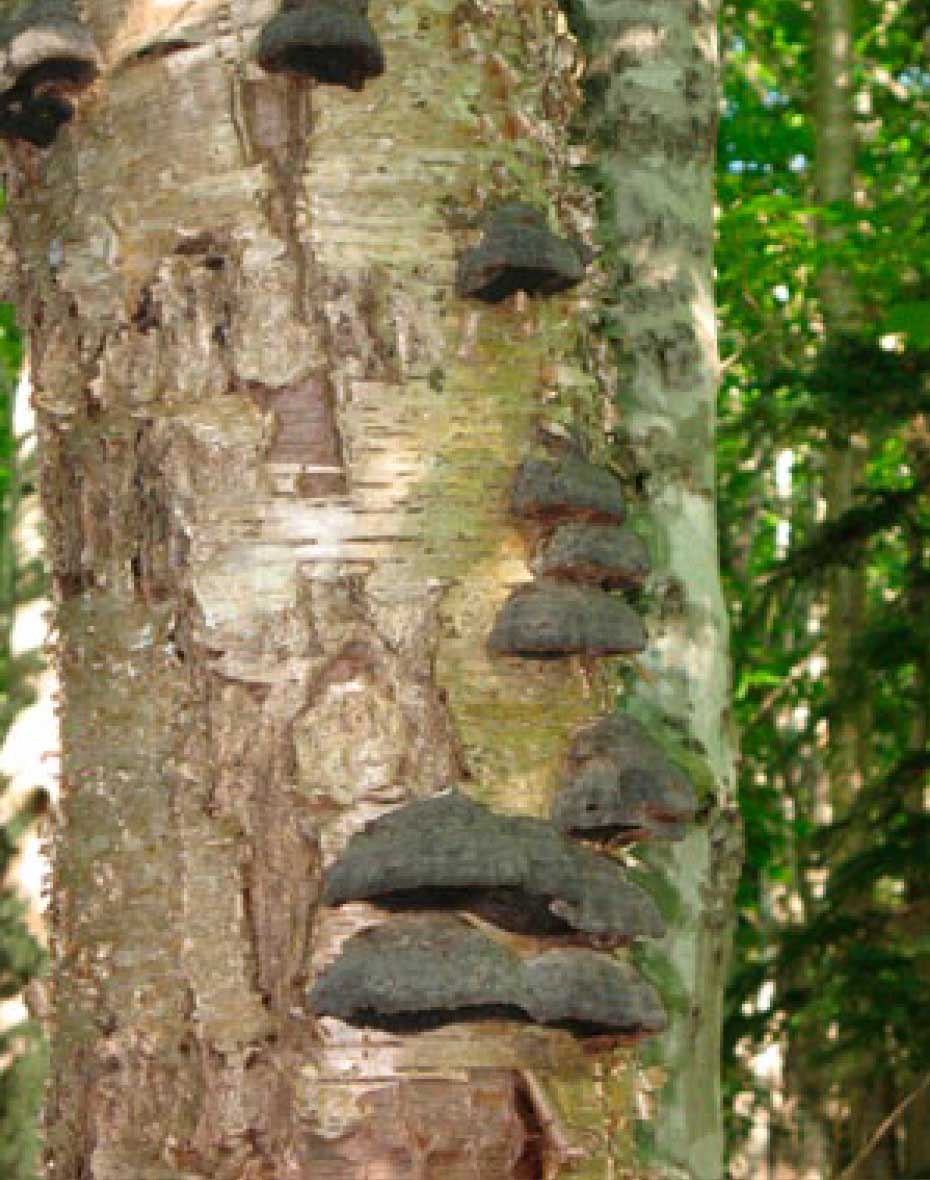 |
| These conks indicated advanced decay in this yellow birch. |
Such small-scale disturbances are constantly occurring over our forest landscape. As openings occur, other species colonize these sites, perhaps afforded an opportunity by mineral soil unearthed by disgorged roots, or attracted to organic material and moisture provided by the trunk of the tree laying on the forest floor. Blue-spotted salamanders and red efts may seek shelter here, while wood lice mine the decaying wood for nutrients. In its death – whether slow or sudden – the fallen tree has created conditions suited to a procession of new life close to the surface of the soil.
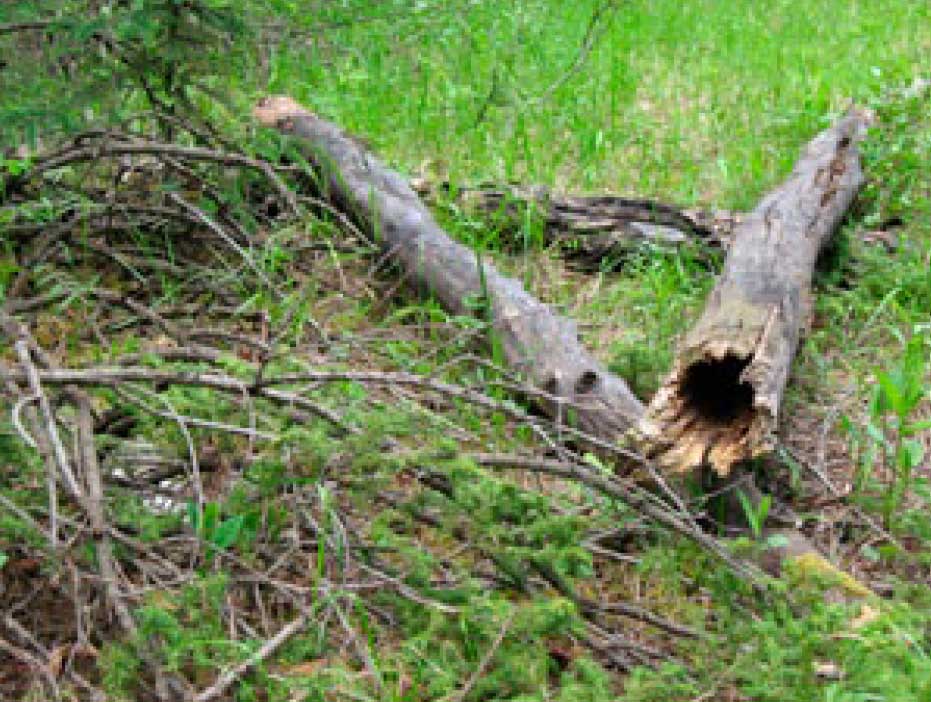 |
|
Coarse woody debris provides essential shelter and nutrients for many organisms |
In this damp, dark interface between the soil and air, a critical layer of activity occurs. Earthworms and white-laced strands of fungi decompose decaying wood and convert it to forms of food that other organisms can use. Twigs, branches, needles and leaves accumulate on the surface of the soil, providing a constant shower of organic matter that is used by bacteria, fungi and insects – the building blocks of a healthy forest.
Using Your knowledge of forest succession and natural disturbance
We’ve discussed how a good understanding of the succession dynamics of your woodland will assist you in determining whether harvesting isappropriate. We’ve looked at natural disturbance patterns, including small gap disturbances and larger disturbances that accompany events like hurricanes and insect outbreaks. It is time to look at your woodland management plan and decide the scale of harvesting that may be appropriate.
Even-aged vs. Uneven-aged Stands
It is important to determine whether the stand you plan to harvest is even-aged or uneven-aged.
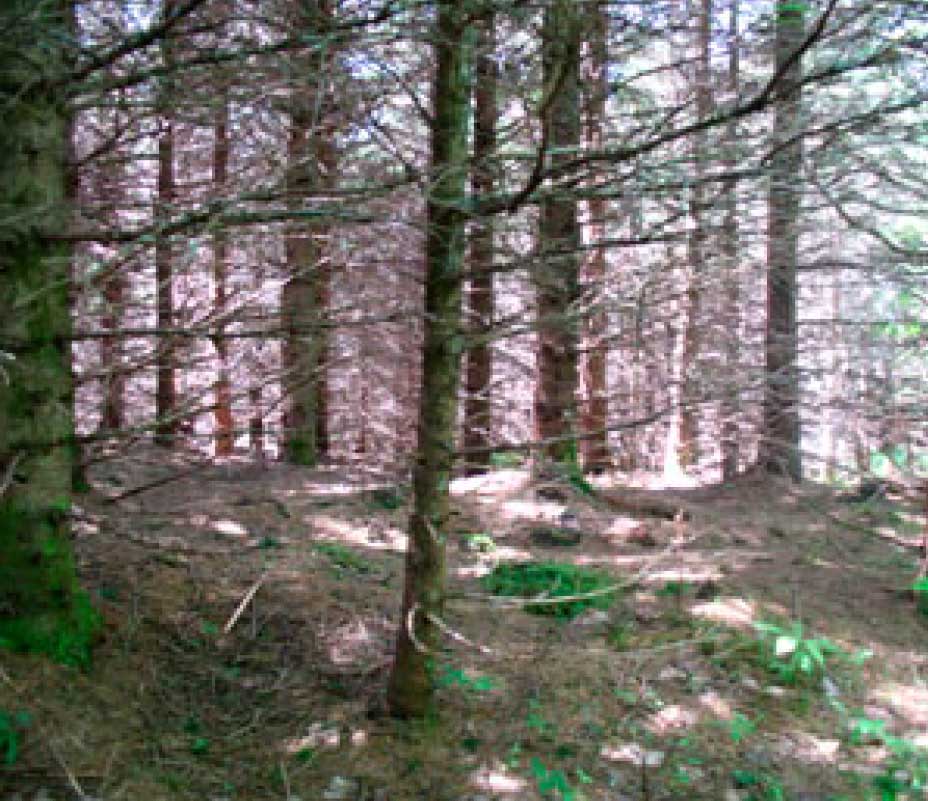 |
| An even-aged stand of old-field white spruce |
Each tree species has an age of maturity, beyond which it will not increase in timber value. Of course, timber value is not the only value that you may have for your woodland. The importance of overmature trees and their value as standing dead wood, or snags, cannot be overestimated. For example, some species such as shade-tolerant hardwoods, can make very good cavity trees, since the inner wood may decay more quickly than the wood close to the bark. This results in a hollow tree that can be used by wildlife.
Even-aged stands are characterized by trees that have become established within a few years of a stand-level disturbance, and are close to the same age. Generally
speaking, an even-aged forest becomes more susceptible to natural disturbance as it grows older. As trees grow taller and their crowns grow larger, they become less windfirm and more disposed to windthrow. As balsam fir trees weaken with age they become more susceptible to widespread outbreaks of spruce budworm (Choristoneura fumiferana), a natural event which occurs in regular cycles in Nova Scotia.
Uneven aged stands contain three or more age classes of trees that have developed from small- scale disturbances. There may be a mixture of all sizes of trees together on the same site. These stands are more complex than even-aged stands, and any management approach should be carefully considered before it is implemented. Again, planning is very important.
 |
| An uneven-aged stand of white pine and red spruce |
Healthy seedlings growing in the shade of larger trees is an important feature of uneven-aged stands. The seedlings are usually shade-tolerant species such as red spruce, eastern hemlock, sugar maple, yellow birch and beech.
These stands, in the absence of large-scale disturbances, can retain their uneven-aged conditions for many decades – even centuries – as individual trees, or small patches of trees, die or are blown down and openings are created in the forest canopy. Some regeneration may already exist in the area of the opening, and these trees often have an advantage over newly-established seedlings as they rapidly expand into the available growing space. The battle for light and space is constantly being waged in an uneven- aged stand, and shade-tolerant and long-lived tree species clearly have an advantage in these conditions.
We have discussed natural disturbance at length because it is important to understand the dynamics that take place within your woodland over time. It is especially important to consider how a stand will regenerate, and with what species. Harvesting can be used as a tool to promote regeneration, and you should ponder what you would like the next stand to look like.
We’re now ready to discuss harvesting approaches in the context of natural disturbance.
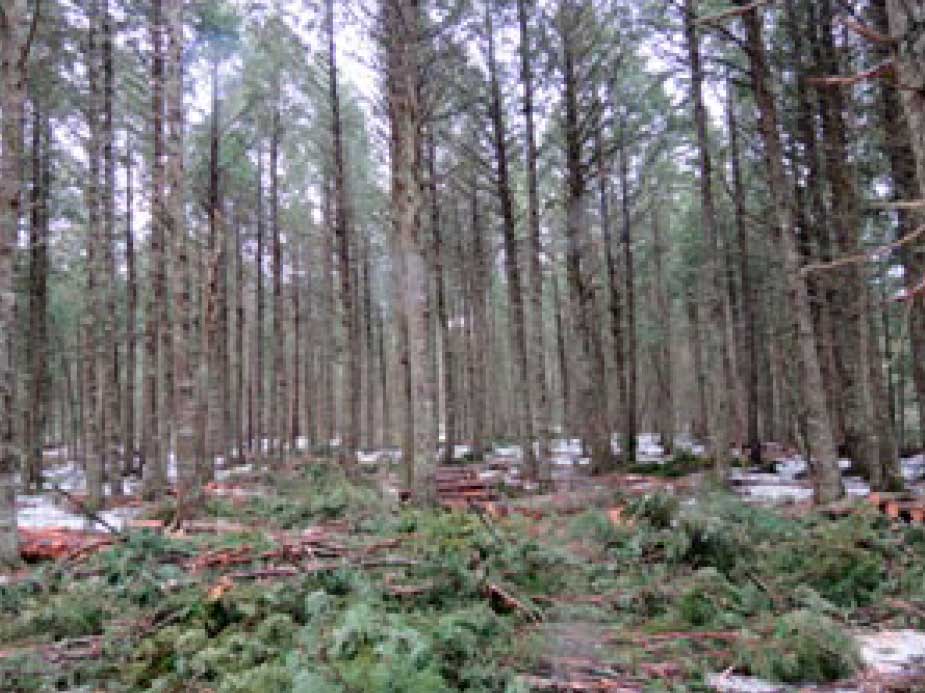 |
|
A partially-harvested stand of hemlock |
